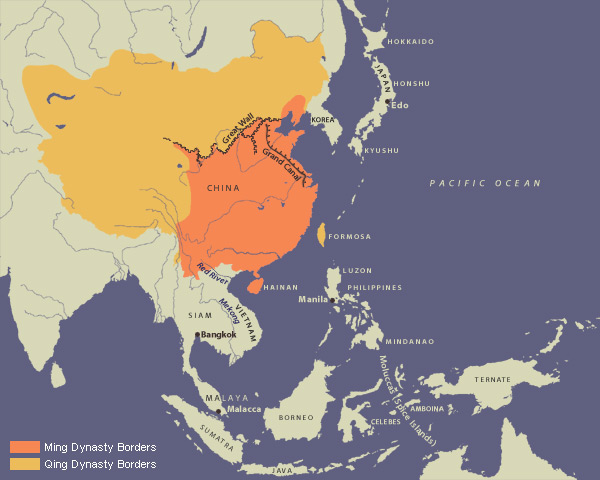Rethinking the Industrial Revolution
Rethinking Regions
As we think about Asia in the curriculum and about Asia in world history, we need to rethink regions. Here my concern is with the problems we have now that we're all escaping the conceptual tyranny of constantly thinking in terms of the national state. Scholars, often motivated by the subordination of national states in Europe to the European Union, recognize that the national state isn't going to be around forever, at least in its European form. Whether in the humanities or social sciences, they have moved in one of two directions.

Map of Asia showing Qing and Ming era borders
There are those who have moved down to the level of the local, and celebrated the uniqueness of whatever they're studying at a micro level. And there are others who have moved up to the scale of the world and alerted us to some common, global human experiences. We have very few conceptual stepping stones between the very local and the global now that the national state is no longer as important as it once was. We need to consider some new kinds of geographical spaces between the local and the global.
Regional Analysis of China [VIDEO]
TRANSCRIPT: When we talk about China, we should be careful not to talk about China in some holistic way. Indeed, many of (the people) we called "Chinese" when they moved into Southeast Asia, they don't think of themselves, it doesn't seem to me, as self-consciously Chinese until a relatively late point in time. That is to say, there were ... different kinds of Chinese that only become "Chinese" in a more general sense once certain kinds of nationalistic propaganda are promoted in the late nineteenth and early twentieth centuries.
So that's one kind of region. However, there are other regions (Chinese geography can be broken down in other ways). We can put the northwest of China into an inner-Asian or central-Asian region. And notice how the dynamics in that area are instantly tied to what goes on, across what become Qing borders, to other parts of Central Asia. That's another kind of way of breaking up China. Equally, there are ways of building larger East Asias that take seriously that China, Japan, Korea, parts of Southeast Asia are connected together, at the same time as we don't reinvent civilizational units.
There are really good reasons to have very flexible notions of region, which can be defined differently for different purposes. In other words, we should recognize that the spatial units within which we do our research and teaching need not always be the national state or, alternatively, always the same region. Regions were often defined in the past as "civilizations" and assumed to share some common or homogeneous traits, but as we have learned that tremendous diversity and variation exist within any large civilization, we can instead think about how common features, such as Confucian ideas in East Asia, supply a number of concepts and institutions from which people can make choices that combine with other more specific themes in their particular settings, be these some part of China, Japan, or Korea.